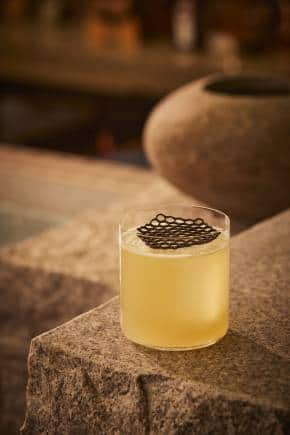



With the change in weather upon us, can the sniffles be far behind? For us Indians, it’s almost instinctive to get our hands on home remedies like mulethi or licorice to cure any seasonal issue. After all, licorice root serves as the perfect antidote to a sore throat, with its antiviral and anti-inflammatory properties. Chewing on these sticks has been an age-old practice that has been passed down generations and for good reason. Some also have it as tea to soothe their nerves or build immunity. In a nutshell, this medicinal root either has many takers, or is despised for its peculiar taste – there’s no in-between.
 Mulethi cocktail at Loya
Mulethi cocktail at LoyaWhat if we told you that this natural remedy is finding its way into hotel and restaurant kitchens to elevate the taste of food and cocktails? Mulethi is slowly and steadily making inroads into the culinary industry. But what makes it so favourable in such preparations? Let’s ask the experts.
Magic of mulethiMulethi or sweetwood has been used as a flavouring agent for candies, baked goods, ice-creams, chewing gum, and even soft drinks for the longest time the world over, explains Swapnadeep Mukherjee — Executive Chef, The Metropolitan Hotel and Spa New Delhi. Back home, restaurants and hotels are now experimenting with this ingredient to create health drinks like mulethi kadha, ginger-mulethi tea, or mulethi root tea.
“There are a few restaurants that add mulethi instead of sugar in tea. It does not have an initial sweet taste; instead, the flavour builds up with every sip. When it comes to food, the industry is still exploring the ingredient,” he says.
Mulethi powder, to be precise, is gaining popularity because it's decidedly sweeter and can blend easily into various dishes. From adding a pinch of mulethi to marinated white meats/fish to using it as a dressing for cooked/raw vegetables, diners and chefs of gourmet cuisine are raving about this ingredient, notes Gaurav Misra — Executive Chef, DoubleTree by Hilton Jaipur Amer.
“We use mulethi in varied ways in our kitchen. Our chefs add mulethi to doughs to make soft cakes or fresh pasta, and risotto. It also blends excellently with light fish and shellfish sauces, and works as a good combination with oats,” he adds.
Chef Manoj Pandey, Partner Chef, The Piano Man, explains that the most innovative method of incorporating mulethi is to use its smoke to add a certain flavour into the main dish, “The mulethi sticks can be directly used in kahwa tea as well as in the homemade masala mixture, which elevates the nutritional profile of the dish.”
Mulethi may be used in desserts and soups, Dr Chaitanya Kumar – Faculty, Lexicon Institute of Hotel Management, says, but there’s a caveat — since the 'sugar' in licorice is 50 times sweeter than sucrose, high intake can raise blood pressure levels. That’s why chefs need to be well-trained in its use.
“Finding food-grade licorice powder is quite difficult; medicinal grade licorice or licorice in the raw form is not suited for cooking. It needs to be well-processed,” he explains, adding that mulethi can be used like an herb.
Mulethi-based cocktailsThe new Taj Palace New Delhi restaurant — Loya — has a cocktail programme that uses mulethi as a prominent ingredient. Harsh Champawat — Director of Food and Beverage at the hotel shares, “We create a signature drink using mulethi-infused gin, sugar and a honeycomb tuile called Loya citrus blend. Panjj or paanch, meaning ‘five’, is our take on drinks inspired by the number ‘five’ and its great significance across India. From the five rivers of the north to the five senses, the five elements of life, and closer home, in the five tenets of Loya’s cocktail philosophy — Harmony, Experimentation, Authenticity, Reverence, and The Spirit come together to signify the heart of the north.”
DoubleTree by Hilton Jaipur Amer also uses mulethi in mocktails and cocktails. One of their popular mocktails, an immunity-booster, contains ingredients like mulethi, ginger juice, lime juice, honey, warm water and a special spice mix.
“We also offer a cocktail Mulethi Twist that uses mulethi, ginger juice, lime juice, honey, dark rum, and a special spice mix...ingredients that are great for fighting a cold,” he shares.
Did anyone say guilt-free indulgence this Valentine's Day?
Discover the latest Business News, Sensex, and Nifty updates. Obtain Personal Finance insights, tax queries, and expert opinions on Moneycontrol or download the Moneycontrol App to stay updated!
Find the best of Al News in one place, specially curated for you every weekend.
Stay on top of the latest tech trends and biggest startup news.